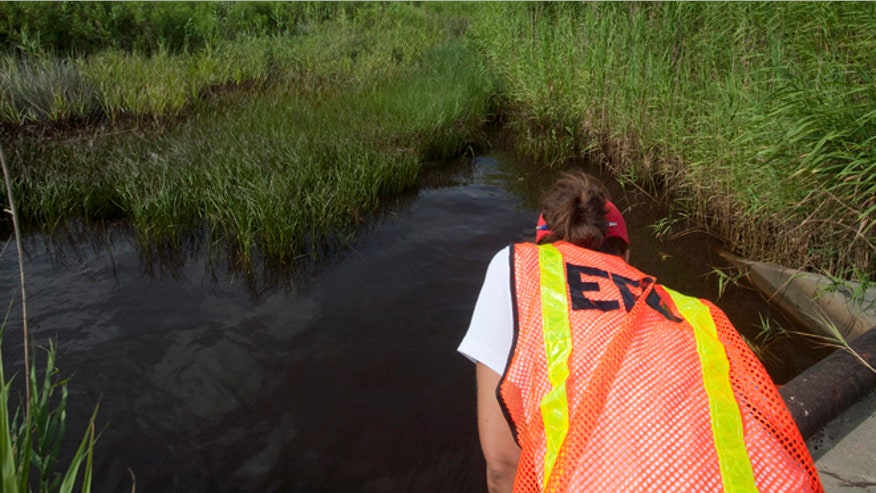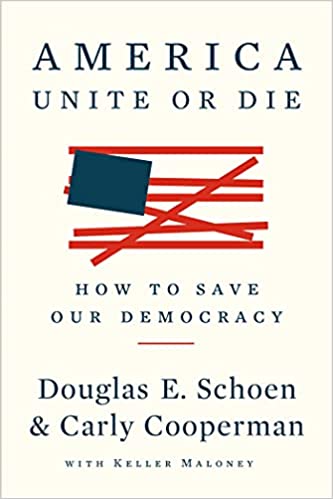
In this July 7, 2010 file photo, an EPA worker looks at oil from the Deepwater Horizon spill which seeped into a marsh in Waveland, Miss. (Reuters)
A river runs through it — and Uncle Sam isn’t far behind.
That’s what several Republican lawmakers and even state farming groups and local governments are warning, after a draft rule from the Environmental Protection Agency proposed expanding which waterways are federally protected under the Clean Water Act.
The concern is that the move could give the feds authority over virtually any stream or ditch, and hand environmentalists another way to sue property owners. In other words, critics say, the government might soon be able to declare jurisdiction over a seasonal stream in your backyard.
If so, good luck getting a permit to expand building space on your property, or marketing your land to prospective developers.
“(The) draft rule sent to the White House for review could expand the EPA’s regulatory power to give the agency unprecedented new authority over seasonal streams and ditches on private property,” Rep. Lamar Smith, R-Texas, chairman of the House Science, Space and Technology Committee, said in a statement to FoxNews.com.
The EPA flatly denies this charge. Officials told FoxNews.com that the draft rule, which was published on Nov. 8, is nothing like its detractors claim. “The proposed rule would not expand EPA’s or the (Army Corps of Engineers’) jurisdiction or protect any new waters that have not historically been covered under the Clean Water Act,” the agency told FoxNews.com.
“In fact, the proposed rule specifically takes into account the more narrow reading of Clean Water Act jurisdiction established by the Supreme Court.”
The EPA and its supporters say “mass confusion” over what constitutes a protected water body under the 1972 Clean Water Act (CWA), has been fueled mostly by a host of narrow rulings by the Supreme Court, and a lack of clarity in the current law.
In the most recent court case, Rapanos v. The United States, Justice Anthony Kennedy proclaimed that in order for an isolated wetland or smaller body of water (like a stream) to be protected under the CWA, the science must show a “significant nexus” to waters already protected under the law, like major river systems and lakes.
Jan Goldman-Carter, senior wetlands and water resources counsel with the National Wildlife Fund and supporter of the new rule, says the EPA is doing just what Justice Kennedy suggested — establishing, with scientific criteria, the kind of wetlands and water bodies that have a “significant nexus” to protected waters. These waters and wetlands are in the floodplain of “navigable waters,” and would meet the test anyway, she insists. Now it’s in black and white.
“(The new rule) is almost entirely about clarification,” she said. “The big difference is it will all be understood up front so you won’t have to waste agencies’ time and resources and landowners’ time and resources doing it all case-by-case.”
But the idea that there would be no expansion of the number of water bodies or wetlands covered under the CWA is disingenuous, say other legal experts, who see plenty of room for EPA creep and bureaucratic red tape in the proposed measure.
“Under the leaked draft rule, more waters would be facially jurisdictional than under the current regime,” said attorneys Lowell Rothschild and Matthew Haynie, who both provide consulting services to developers and industries on environmental and public policy issues.
Writing on their blog for the law offices of Bracewell & Giuliani, LLP, they said the proposed rule “could have significant impact on infrastructure, energy and land development.” The definitions would be changed in more than one way, with “perhaps the most significant” being that many waters and wetlands would meet the “significant nexus” label automatically, bypassing the “fact intensive inquiry” they might have gone through to get those protections in the past.
But John Devine, senior attorney for the National Resources Defense Council, which supports the rule, says the EPA is “grounding these news rules in the science that has already been compiled about how streams and wetlands function in the aquatic system” and that critics are “twisting the facts to meet their political agendas.”
Therein lies the rub. On the other side, critics — who now include local land managers — say the EPA is basing its science on a draft environmental report that has yet to be fully vetted by the independent Science Advisory Board. Rep. Smith joins a number of Republican lawmakers in hoping to stop the rule from going forward, at least until that draft report, which provides justification for the new rule, is given a proper public airing.
Further, critics contend the report itself goes too far. When it was released for public comment in October, Nita Taylor, county manager of Lincoln, New Mexico, told her fellow commissioners she interpreted the report as the EPA and Army Corps of Engineers seeking to “gain jurisdiction over all water in the United States, and all activities affecting all water; and to regulate water now considered entirely under state jurisdiction.”
Other commissioners agreed and suggested joining forces with neighboring county governments to fight the EPA on this front. They see federal bureaucracy getting in the way of their land management. “It’s bad enough with the state in charge. Turning it over to federal agencies would be disastrous,” County Commission Chairman Jackie Powell told reporters.
Meanwhile, in comments submitted to the EPA, the South Carolina Farm Bureau warned that the report appears to say that “streams and most wetlands are connected and exert and influence on downstream waters” — however, the “EPA stops short of asking important questions about the scientific significance of these connections.” David Winkles, Farm Bureau president, wrote it would seem “any measurable connection would be enough” to declare a water body or wetland under federal jurisdiction.
Proponents note that many areas will still be considered on a case-by-case basis, according to both the report and draft rule. But those elements are being ignored for political reasons, they say. “Industry and members of Congress calling EPA’s actions an overreach are the same people who deny science and reasonable environmental protections on a whole host of other issues,” charged Dalal Aboulhosn, spokesman for Sierra Club, which supports the rule.
Smith says the devil is in the details, and that the EPA appears to be rushing forward to avoid scrutiny.
“The agency’s own science advisors have not had the opportunity to review the science underpinning this rule,” he said. “Any rule that could give EPA the authority to tell us what to do in our own backyards needs to be supported by sound science.”

